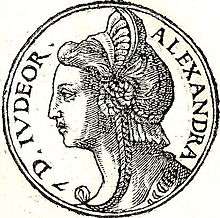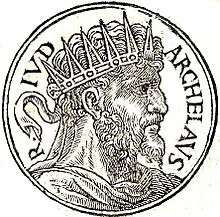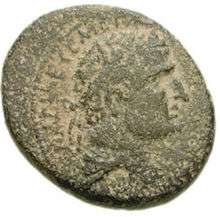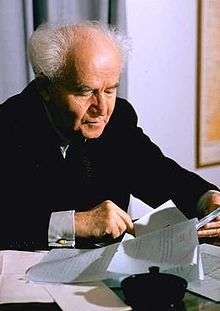List of Jewish leaders in the Land of Israel
Part of a series on the |
|---|
| History of Israel |
 |
| Ancient Israel and Judah |
| Second Temple period (530 BCE–70 CE) |
| Middle Ages (70–1517) |
| Modern history (1517–1948) |
| State of Israel (1948–present) |
| History of the Land of Israel by topic |
| Related |
|
|
The following is a list of Jewish heads of state and/or government in the Land of Israel.
House of Saul
- King Saul (c. 1079–1007 BCE)
- King Ishbosheth (II Samuel 2:8–9)
House of David
- King David (II Samuel 5:3) c. 1004–970 BCE – who made Jerusalem the capital of the United Kingdom of Israel.
- King Solomon (I Kings 2:12)
- King Rehoboam (I Kings 11:43)
After Rehoboam
After Rehoboam reigned three years (1 Chronicles 11:17), the kingdom was divided in two – the northern kingdom of Israel under Jeroboam, with its capital, first in Shechem (Nablus), then Tirzah, and finally Samaria, and ruled by a series of dynasties beginning with Jeroboam; and the southern kingdom of Judah with its capital still at Jerusalem and still ruled by the House of David. The following list contains the kings of Judah with the kings of Israel in the summaries:
- King Abijah (I Kings 14:31) c. 915–913 BCE
- King Asa (I Kings 15:8) – under whose reign, the following were kings in Israel: Nadab, Baasha, Elah, Zimri, Omri, and Ahab.
- King Jehoshaphat (I Kings 15:24) – under whose reign, Ahaziah and Yehoram reigned in Israel.
- King Yehoram ben Yehoshaphat (I Kings 22:50)
- King Ahaziah ben Yehoram (II Kings 8:24) – under whose reign, Jehu ruled in Israel.
- Queen Athaliah (II Kings 11:3) mother of Ahaziah
- King Yehoash (II Kings 11:21) – son of Ahaziah, under whose reign, Yehoahaz and another Yehoash ruled in Israel.
- King Amaziah (II Kings 14:1) – under whose reign, Jeroboam II ruled in Israel.
- King Uzziah referred to as Azariah (II Kings 15:1) – under whose reign, the following ruled over Israel: Zachariah, Shallum, Menahem, Pekahiah, and Pekah.
- King Yotam (II Kings 15:32)
- King Ahaz (II Kings 16:1) – under whose reign, Hoshea ruled as the last king of Israel.
- King Hezekiah (II Kings 18:1) – under his reign, the Assyrian Empire conquered and destroyed the northern kingdom 722 BCE leaving only the southern kingdom of Judah.
- King Manasseh (II Kings 20:21)
- King Amon (II Kings 21:18)
- King Josiah (II Kings 21:26)
- King Yehoahaz (II Kings 23:30) son of Josiah
- King Yakim (II Kings 23:34) son of Josiah
- King Yachin (II Kings 24:6) son of Jehoiakim
- King Zedekiah (II Kings 24:17) – son of Josiah, last king to rule over, and in, Judah. Overthrown by Babylonia (which succeeded Assyria) and exiled, along with most of the rest of the population, to that kingdom, where he was executed.
- Gedaliah (II Kings 25:22–23) son of Ahikam advisor to King Josiah; he became governor over the remnant of Judah in their homeland and was assassinated the next year.
Governors of the Persian Province of Judea
- Zerubbabel (Ezra 3:8) son of Shealtiel. In the first year of the reign of Cyrus, successor to Darius, the Jews were allowed to return to their homeland. Zerubbabel led the first group of returnees and ruled in Judea for two years. The date is generally thought to have been between 538 and 520 BC.[1] The House of David had survived, but struggled to reclaim its place as the ruling House of Israel.
- Nehemiah (Book of Nehemiah) arrived in Jerusalem in 445 as governor of Judah, appointed by Artaxerxes.[2]
- Hananiah (Nehemiah 7:2)
Hasmonean dynasty 168–37 BCE

The Maccabees founded the Hasmonean dynasty, which ruled from 168 BCE – 37 BCE, reasserting the Jewish religion and expanding the boundaries of the Land of Israel by conquest.[3] In the post-Maccabean period the high priest was looked upon as exercising in all things, political, legal, and sacerdotal, the supreme authority.[4]
- Mattityahu – who began a war for independence.
- Judah – during whose reign, Alcimus succeeded Menelaeus as high priest.
- Jonathan – assumed the high priesthood.
- Simon – succeeded his brother Jonathan as high priest and was also installed as ethnarch and commander-in-chief. Under his reign, Judea gained its independence.
- John Hyrcanus I – also succeeded as high priest.
- Aristobulus – also high priest.
- Alexander Jannaeus – high priest and king.
- Salome Alexandra
- Hyrcanus II – succeeded Alexander as high priest beginning with the rule of Salome.
- Aristobulus II – succeeded as high priest. During his reign, Judea lost its independence and passed under the rule of Rome (63 BCE) who overthrew him and reinstalled:
- Hyrcanus II as high priest
- Antigonus – also high priest
Herodian dynasty (37 BCE – 70 CE)

- King Herod the Great
- King Herod Archelaus (4 BCE – 6 CE), Ethnarch of the Tetrarchy of Judea
After Archelaus and during the intervening period, the Sanhedrin, founded by Ezra, became the sole rulers of the Jewish people in Judea in conjunction with the High Priest. The heads, or nesiim, of the Sanhedrin beginning in 20 BCE, was Hillel the Elder, his son Shimon, and his son Gamaliel I whose rule extended into the reign of:[5]

- King Agrippa I (41–44)
- King Herod II (44–48)
- King Agrippa II (48–73). In 66 CE, the great revolt began against Rome, resulting in the Zealot Temple Siege and culminating in the destruction of the Temple in Jerusalem in 70 CE, the abolition of the High Priesthood, and the final defeat at Massada in 73. Agrippa II was exiled to Rome during the revolt where he died.
Palestinian Patriarchate 80–429 CE
The Palestinian Patriarchate was the governing legalistic body of Palestinian Jewry after the destruction of the Second Temple until about 429[6] CE. Being a member of the house of Hillel and thus a descendant of King David, the Patriarch, known in Hebrew as the Nasi (prince), enjoyed almost royal authority.[7]
- Gamaliel II of Jamnia (80–115)
- Eleazar ben Azariah (115–120)
- Interregnum (Bar Kokhba revolt) (132–135)
- Judah bar Ilai c. 140 moved the Sanhedrin to Usha
- Shimon ben Gamliel II
- Judah I haNasi (170–220) – ruled from Bet Shearim, then Sepphoris
- Gamaliel III (220–230)
- Judah II (230–270) – ruled from Sepphoris, then Tiberias. This was the Sanhedrin’s last move.
- Gamaliel IV (270–290)
- Judah III (290–320)
- Hillel II (320–365) – 320 is given as the traditional date for the codification of the "Palestinian" Talmud
- Gamliel V (365–385)
- Judah IV (385–400) – in 395, the Roman Empire split into east and west and Palestine passed under the eastern Byzantine Empire.
- Gamaliel VI (400–425) – on 17 October 415, an edict issued by the Emperors Honorius and Theodosius II deposed Gamaliel VI as nasi. Theodosius did not allow the appointment of a successor and in 429 terminated the Jewish patriarchate.[6]
Hacham Bashi (1842–1918)
Hakham Bashi is the Ottoman Turkish name for the Chief Rabbi of the nation's Jewish community.[8]
- Avraham Haim Gaggin (b. Turkey) 1842–1848
- Isaac Kovo 1848–1854
- Haim Abulafia 1854–1860
- Haim Hazzan (b. Turkey) 1860–1869
- Avraham Ashkenazi (b. Greece) 1869–1880
- Raphael Meir Panigel (b. Bulgaria) 1880–1893
- Jacob Saul Elyashar 1893–1906
- Jacob Meir 1906–1907
- Elijah Moses Panigel 1907–1908
- Nahman Batito 1908–1915
- Nissim Danon 1915–1918 – In 1917, Palestine was conquered by the British. Danon was succeeded as chief rabbi after World War I by Haim Moshe Eliashar who assumed the title of Acting Chief Rabbi 1918–1921. (For a list of Chief Rabbis during the Mandate and afterwards, see Wikipedia article "Chief Rabbinate of Israel – List of Chief Rabbis (Mandatory Palestine – State of Israel).) They controlled religious affairs while:
The Jewish National Council (1917–1948)

The Jewish National Council (Vaad Leumi) controlled civil affairs, as defined by a British Mandatory Ordinance. The following list contains the elected chairmen of the Jewish National Council.[9]
- Yaacov Thon (b. Ukraine) 1917–1920 – head of a provisional council which preceded the actual formation of the Vaad Leumi in 1920.
- David Yellin 1920–1929
- Pinhas Rutenberg (b. Ukraine) 1929–1931
- Yitzhak Ben Zvi (b. Ukraine) – elected as chairman in the 1931 elections, held the office until independence in 1948. In 1939, Pinhas Rutenberg was, once again, appointed chairman of the Va'ad while Ben Zvi became President. He held that position until his death in 1942. In the 1944 elections, *David Remez (b. Ukraine), was elected as chairman while ben Zvi continued with the title of President.
The Prime Minister 1948–

- David Ben-Gurion (b. Poland) 1948–1953
- Moshe Sharett (b. Ukraine) 1953–1955
- David Ben-Gurion 1955–1963
- Levi Eshkol (b. Ukraine) 1963–1969
- Golda Meir who came from Ukraine via the United States 1969–1974
- Yitzhak Rabin 1974–1977
- Menachem Begin (b. Belarus) 1977–1983
- Yitzhak Shamir (b. Poland) 1983–1984
- Shimon Peres (b. Poland) 1984–1986
- Yitzhak Shamir 1986–1992
- Yitzhak Rabin 1992–1995
- Shimon Peres 1995–1996
- Benjamin Netanyahu 1996–1999
- Ehud Barak 1999–2001
- Ariel Sharon 2001–2006
- Ehud Olmert 2006–2009
- Benjamin Netanyahu 2009–present
See also
References
- ↑ Janet E. Tollington, "Tradition and Innovation in Haggai and Zechariah 1-8" (Sheffield, England: Sheffield Academic Press, 1993), 132.
- ↑ F. Charles Fensham. The Books of Ezra and Nehemiah. Wm. B. Eerdmans Publishing, 1983. Historical Background chapter. p.7
- ↑ The Oxford History Of The Biblical World. Oxford University Press. 2001. Chapter 9
- ↑ Hirsch, Emil G. (1901–1906). "High Priest". Jewish Encyclopedia.
- ↑ Encyclopedia Judaica (ed. Cecil Roth, 1971), "Sanhedrin", "Hillel", "Gamaliel I"
- 1 2 Pharr, Clyde (1952). The Theodosian Code and Novels and the Sirmondian Constitutions. Princeton: Princeton University Press.
- ↑ Hugh Chisholm (1911). Encyclopædia Britannica: a dictionary of arts, sciences, literature and general information. The Encyclopædia Britannica company. p. 403. Retrieved 18 July 2011.
- ↑ Jewish Encyclopedia, "Jews of Jerusalem" "Institutions"; Encyclopedia Judaica – "Israel, State of" – Religious Life and Communities – vol. 9 cols. 889–90
- ↑ Encyclopedia Judaica – "Israel, State of" – Governance – Jewish Communal Organization – The Asefat ha-Nivharim and the Va'ad Le'ummi – vol. 9 cols. 608–9